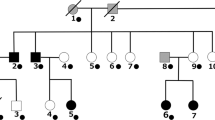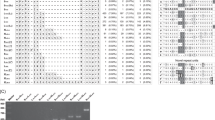Abstract
Aromatic L-amino acid decarboxylase (AADC) is a relatively non specific enzyme involved in the biosynthesis of several classical neurotransmitters including dopamine and 5-hydroxytryptamine (5HT; serotonin).1 AADC does not catalyse the rate limiting step in either pathway, but is rate limiting in the synthesis of 2-phenylethylamine (2PE) which is a positive modulator of dopaminergic transmission and a candidate natural psychotogenic compound.1 We and others have proposed that polymorphism in AADC resulting in altered 2PE activity might contribute to the pathogenesis of psychosis.1,2 In order to test this hypothesis, we have used denaturing high performance liquid chromatography (DHPLC)3 to screen 3943 bases of the aadc gene and its promoter regions for variants that might affect protein structure or expression in 15 unrelated people with schizophrenia, and 15 unrelated people with bipolar disorder. three polymorphisms were identified by dhplc: a insertion/deletion polymorphism in the 5′ utr of the neuronal specific mrna (g.-33–30delagag, bases 586–589 of genbank m77828), a t>a variant in the non-neuronal exon 1 (g.-67t>a, genbank m88070), and a g>a polymorphism within intron 8 (g.ivs8 +75g>A, GenBank M84598). Case-control analysis did not suggest that genetic polymorphism in the AADC gene is associated with liability for developing schizophrenia or bipolar disorder.
This is a preview of subscription content, access via your institution
Access options
Subscribe to this journal
Receive 12 print issues and online access
$259.00 per year
only $21.58 per issue
Buy this article
- Purchase on Springer Link
- Instant access to full article PDF
Prices may be subject to local taxes which are calculated during checkout
Similar content being viewed by others
References
Berry MD, Juorio AV, Li X-M, Boulton AA . Aromatic L-amino acid decarboxylase: a neglected and misunderstood enzyme Neurochem Res 1996; 21: 1075–1087
Buckland PR, Spurlock G, McGuffin P . Amphetamine and vigabatrin down regulate aromatic L-amino acid decarboxylase mRNA levels Brain Res Mol Brain Res 1996; 35: 69–76
Underhill PA, Jin L, Lin AA, Mehdi SQ, Jenkins T, Vollrath D et al. Detection of numerous Y chromosome biallelic polymorphisms by denaturing high performance liquid chromatography (DHPLC) Genome Res 1997; 7: 996–1005
Sandler M, Reynolds GP . Does phenylethylamine cause schizophrenia? Lancet 1976; 1: 70–71
Davis BA, Shrikande S, Paralikar VP, Hirsch SR, Durden DA, Boulton AA . Phenylacetic acid in CSF and serum in Indian schizophrenic patients Prog Neuropsychopharmacol Biol Psychiatry 1991; 15: 41–47
O'Reilly R, Davis BA, Durden DA, Thorpe L, Machnee H, Boulton AA . Plasma phenylethylamine in schizophrenic patients Biol Psychiatry 1991; 30: 145–150
Reith J, Benkelfat C, Sherwin A, Yasuhara Y, Kuwabara H, Andermann F et al. Elevated dopa decarboxylase activity in living brain of patients with psychosis Proc Natl Acad Sci USA 1994; 91: 11651–11654
Buckland PR, O'Donovan MC, McGuffin P . Changes in dopa decarboxylase mRNA but not tyrosine hydroxylase mRNA levels in rat brain following antipsychotic treatment Psychopharmacology 1992; 108: 98–102
Buckland PR, Marshall R, Watkins P, McGuffin P . Does phenylethylamine have a role in schizophrenia? LSD and PCP up-regulate aromatic L-amino acid decarboxylase mRNA levels Brain Res Mol Brain Res 1997; 49: 266–270
Sobell JL, Heston LL, Sommer SS . Delineation of genetic predisposition to multifactorial disease: a general approach on the threshold of feasibility Genomics 1992; 12: 1–6
Sumi-Ichinose C, Ichinose H, Takahashi E, Hori T, Nagatsu T . Molecular cloning of genomic and chromosomal assignment of the gene for human aromatic L-amino acid decarboxylase, the enzyme for catecholamine and serotonin biosynthesis Biochemistry 1992; 31: 2229–2238
Chireux M, Raynal JF, Le Van Thai A, Cadas H, Bernard C, Martinou I et al. Multiple promoters of human choline acetyltransferase and aromatic L-amino acid decarboxylase genes J Physiol Paris 1994; 88: 215–227
O'Donovan MC, Oefner PJ, Roberts SC, Austin J, Hoogendoorn B, Guy C et al. Blind analysis of denaturing high performance liquid chromatography as a tool for mutation detection Genomics 1998; 52: 44–49
Jones A, Austin J, Hansen N, Hoogendoorn B, Oefner PJ, Cheadle JP et al. Optimal temperature selection for mutation detection by denaturing HPLC and comparison to single-stranded conformation polymorphism and heteroduplex analysis Clin Chem 1999; 45: 1133–1140
American Psychiatric Association . Diagnostic and Statistical Manual of Mental Disorders (4th edition) American Psychiatric Association: Washington DC 1994
McGuffin P, Farmer A, Harvey I . A polydiagnostic application of operational criteria in studies of psychotic illness. Development and reliability of the OPCRIT system Arch Gen Psychiatry 1991; 48: 764–770
Wing JK, Cooper JE, Sartorius N . Measurement and Classification of Psychiatric Symptoms Cambridge University Press: Cambridge 1972
Wing JK, Babor T, Brugha T, Burke J, Cooper JE, Giel R et al. SCAN: Schedules for clinical assessment in neuropsychiatry Arch Gen Psychiatry 1990; 47: 589–593
Owen MJ, Holmans P, McGuffin P . Association studies in psychiatric genetics Mol Psychiatry 1997; 2: 270–273
O'Donovan MC, Guy C, Craddock N, Bowen T, McKeon P, Macedo A et al. Confirmation of association between expanded CAG/CTG repeats and both schizophrenia and bipolar disorder Psychol Med 1996; 26: 1145–1153
Acknowledgements
This study was supported by a grant from the Wellcome Trust (052309) and an MRC Programme Grant (G9309834). J Austin is funded by a University of Wales College of Medicine Studentship. Ian Jones is a Wellcome Trust Research Fellow in Mental Health. Nick Craddock is a Wellcome Trust Senior Research Fellow in Clinical Sciences.
Author information
Authors and Affiliations
Corresponding author
Rights and permissions
About this article
Cite this article
Speight, G., Turic, D., Austin, J. et al. Comparative sequencing and association studies of aromatic L-amino acid decarboxylase in schizophrenia and bipolar disorder. Mol Psychiatry 5, 327–331 (2000). https://doi.org/10.1038/sj.mp.4000717
Received:
Revised:
Accepted:
Published:
Issue Date:
DOI: https://doi.org/10.1038/sj.mp.4000717
Keywords
This article is cited by
-
The genetics of bipolar disorder: genome ‘hot regions,’ genes, new potential candidates and future directions
Molecular Psychiatry (2008)
-
A genetic analysis of serotonergic biosynthetic and metabolic enzymes in migraine using a DNA pooling approach
Journal of Human Genetics (2005)
-
Dopa decarboxylase genotypes may influence age at onset of schizophrenia
Molecular Psychiatry (2001)
-
Dopa decarboxylase gene polymorphisms and attention deficit hyperactivity disorder (ADHD): no evidence for association in the Irish population
Molecular Psychiatry (2001)



